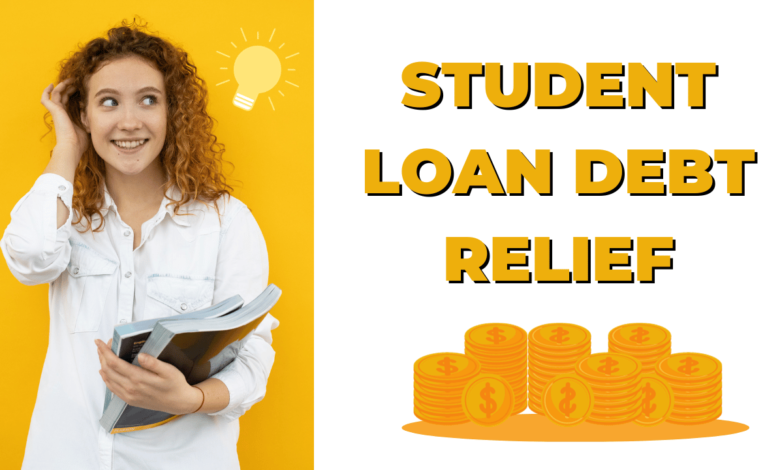5 Best Strategies for Swift Student Loan Debt Relief

Student Loan Debt Relief – Student loan debt can often be overwhelming, casting a shadow over individuals’ financial stability. As education costs rise, many graduates find themselves burdened with substantial debt. Understanding the avenues available for student loan debt relief is crucial in navigating these financial challenges.
Types of Student Loan Debt Relief
1. Loan Forgiveness Programs
Loan forgiveness programs offer relief by forgiving a portion or the entirety of a borrower’s student loan debt. These programs typically target specific professions, such as public service or teaching, providing a pathway to debt elimination based on fulfilling certain criteria.
2. Income-Driven Repayment Plans
Income-driven repayment plans adjust monthly payments based on the borrower’s income, offering relief by making payments more manageable. These plans often extend the repayment period, reducing the monthly financial strain for individuals with lower incomes.
3. Refinancing Options
Refinancing involves obtaining a new loan with better terms to pay off existing student loans. It allows borrowers to secure lower interest rates, potentially reducing the overall amount paid over the loan’s lifetime.
Eligibility Criteria for Relief
1. Federal Loan Eligibility
Federal loans typically offer more options for relief, including forgiveness programs and income-driven repayment plans. Eligibility criteria vary based on the specific relief program.
2. Private Loan Considerations
Private loans may have limited relief options compared to federal loans. Borrowers must explore available options from private lenders or financial institutions for potential relief.
3. How to Apply for Student Loan Debt Relief
Understanding the documentation required and the application process is vital when seeking relief. Detailed documentation of income, loan information, and employment history is often necessary. Navigating the application process accurately can significantly impact the chances of approval.
Impacts of Student Loan Debt Relief
1. Financial Stability and Freedom
Relief from student loan debt fosters financial stability, enabling individuals to allocate funds toward other essential expenses or investments, promoting long-term financial freedom.
2. Credit Score and Financial Planning
Reducing or eliminating student loan debt positively impacts credit scores, allowing individuals to qualify for better financial opportunities and plan for future investments.

Potential Drawbacks of Relief Options
1. Tax Implications
Some relief options may have tax implications, requiring borrowers to consider the potential tax liabilities associated with forgiven debt as part of their financial planning.
2. Extended Loan Terms
While reducing monthly payments, extended loan terms might increase the overall interest paid, affecting the total cost of the loan in the long run.
Tips for Managing Student Loan Debt
1. Budgeting Strategies
Implementing effective budgeting strategies can help manage student loan debt efficiently, ensuring timely payments and financial stability.
2. Seeking Professional Assistance
Consulting financial advisors or loan counselors can provide tailored advice and assistance in navigating relief options effectively.
The Future of Student Loan Debt Relief
1. Policy Changes and Trends
Ongoing policy changes and evolving trends in relief programs may bring new opportunities or alterations in existing relief options.
2. Advancements in Relief Programs
Continuous advancements in relief programs aim to address the increasing burden of student loan debt, offering innovative solutions and support for borrowers.
Conclusion
Navigating student loan debt relief options is essential for individuals seeking financial stability post-education. Understanding the diverse relief avenues available, their eligibility criteria, impacts, and potential drawbacks is crucial in making informed decisions to alleviate this financial burden.
FAQs
Are all student loans eligible for forgiveness programs?
Not all student loans qualify for forgiveness programs; eligibility depends on the loan type and specific program criteria.
How do income-driven repayment plans affect credit scores?
Income-driven repayment plans typically don’t directly impact credit scores; timely payments can positively influence credit over time.
What are the typical documentation requirements for relief application?
Typical documentation for relief applications includes income verification, loan details, employment history, and sometimes tax records.
Can refinancing options be applied to both federal and private loans?
Refinancing options can apply to both federal and private loans, allowing borrowers to secure better terms or rates.
Will seeking student loan debt relief affect future creditworthiness?
Seeking student loan debt relief generally doesn’t negatively impact future creditworthiness if managed responsibly and payments are made on time.

One Comment